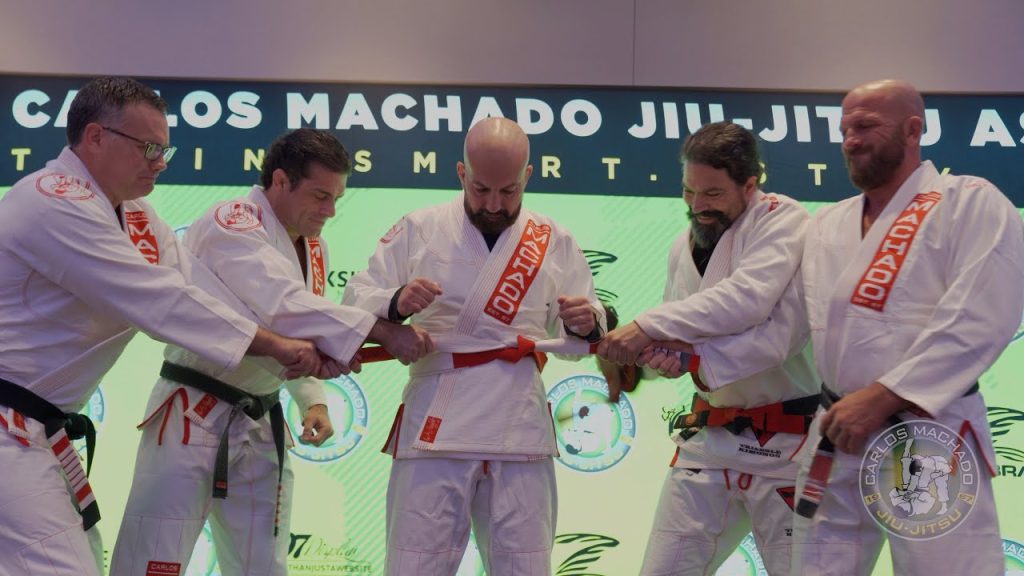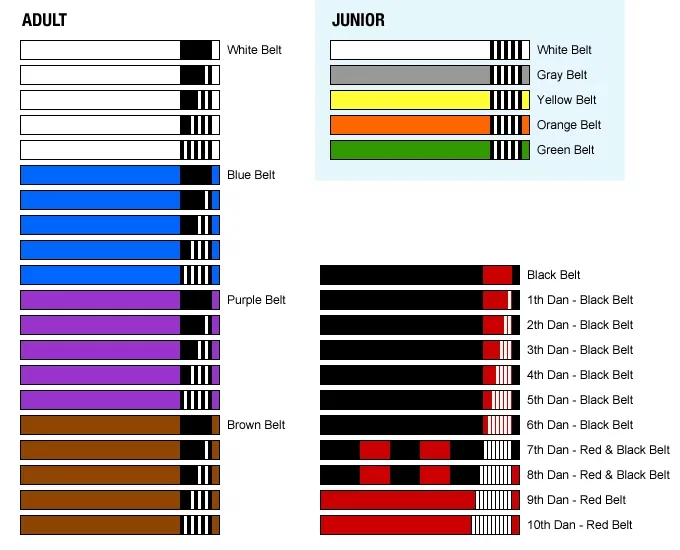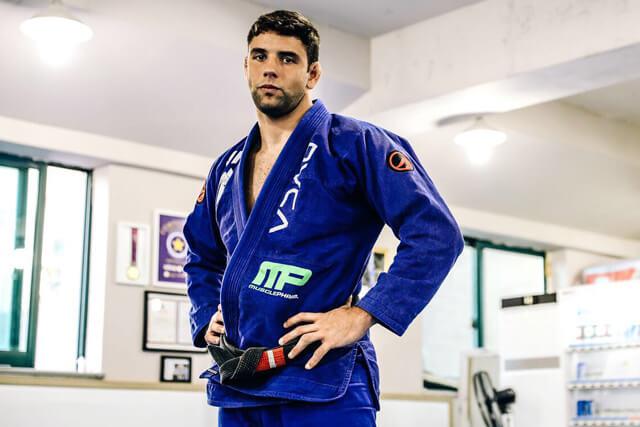The belt system in Brazilian jiu-jitsu (BJJ) is much more than just a ranking indicator. It represents a personal journey, a technical and mental evolution, and a recognition of a practitioner’s commitment. In this article, we will explore the meaning of each belt, from white to black — and beyond.
The Children’s Belt System in Brazilian Jiu-Jitsu
Brazilian jiu-jitsu isn’t just for adults: children as young as 4 years old can begin training through a program adapted to their age and development. The IBJJF (International Brazilian Jiu-Jitsu Federation) has established a specific belt system for young practitioners, distinct from the adult path.
This path includes several ranks ranging from the white belt to the green belt, with each step representing technical improvement, behavioral progress, and commitment on the mats. These belts highlight children’s efforts without exposing them to competitive pressure at all costs.
Children’s Belts in Detail
- White Belt: the starting point for all children. They learn the basics, discipline, and respect for partners.
- Grey Belt: the first real belt promotion, often divided into three levels: grey, grey-white, and grey-black.
- Yellow Belt: symbolizes growing mastery of fundamental techniques. Also divided into three sub-levels (yellow-white, yellow, yellow-black).
- Orange Belt: an intermediate belt for youth aged approximately 10 to 14. Students begin developing a more distinct personal style.
- Green Belt: the final children’s rank, preparing the transition to adult belts. Also includes three sub-levels (green-white, green, green-black).
Progression isn’t based solely on age or time. Attendance, attitude, and the ability to apply lessons are all considered. Between each belt, children can receive stripes on their belts, representing their development.
This system encourages fun, steady, and rewarding learning. It also helps prevent young practitioners from becoming discouraged by the absence of competition, instead regularly celebrating their effort and progress.

The White Belt: The Beginning of the Journey
The white belt symbolizes the beginning. It marks the entry point into the world of Brazilian jiu-jitsu — a phase of total discovery. For many, it’s also the most difficult level, not due to technical complexity, but because of the mental challenge: you must learn to persevere, accept failure, and stay humble when training with more experienced partners.
At this stage, the main objective is to learn the basics: the fundamental positions (mount, guard, half guard, back control), the first defensive movements, control principles, and some simple submissions. The white belt is also when you start developing instincts and learning how to “survive” on the mat.
But beyond technique, mindset is everything. The white belt must learn to self-reflect, observe, and improve step by step. Every submission taken, every lost position is an opportunity to grow.

The Blue Belt: Consolidating the Foundations
Receiving the blue belt is often a relief for practitioners — it marks the end of the “trial by fire” and the beginning of a more technical and structured phase. At this level, you start to understand the bigger picture of jiu-jitsu, recognize common positions, and build your own combinations.
The blue belt is also the stage where confidence begins to grow. You start to dominate white belts, land submissions, and escape difficult positions. But it’s also a tricky period: some stay at this level too long without actively seeking progress.
It’s crucial at this stage to solidify your fundamentals, expand your technical arsenal, and begin developing a personal style. Practitioners should also start thinking about strategy, energy efficiency, and anticipation — not just reacting to opponents.

The Purple Belt: Defining Your Style
The purple belt marks an important transition: you’re no longer a beginner and start being recognized as an experienced practitioner. At this level, technique becomes more fluid and instinctive, with sequences flowing naturally during grappling exchanges.
Most purple belts have a recognizable “game”: a preferred guard style, a go-to strategy, or signature moves. This is also the stage where many begin teaching more frequently, guiding beginners, and reflecting on the pedagogy behind jiu-jitsu.
But the purple belt isn’t just a technical milestone. It also represents mental maturity — the ability to accept failure, manage frustration, and keep progressing despite periods of stagnation. The practitioner begins to think like a future black belt.

The Brown Belt in Brazilian Jiu-Jitsu: On the Path to Mastery
The brown belt is often seen as the final step before earning a black belt. At this stage, the practitioner has strong command of the fundamentals, a solid understanding of transitions, and the ability to adapt to different opponent styles. Techniques are sharpened to reach peak efficiency.
The work at this level is all about details. Practitioners focus on conserving energy, perfecting timing, and making each movement more precise. The game becomes more subtle, more strategic, and mistakes become rare. Brown belts are also seen as role models for the lower ranks.
This is also a time for mental consolidation. A calm and strategic mindset is developed, fights are analyzed with perspective, and teaching is approached with rigor. It’s a pivotal phase where practitioners actively prepare for their transition to black belt.

The Black Belt: The Beginning of a New Journey
Contrary to what some may think, earning a black belt in Brazilian jiu-jitsu is not the end—it marks the beginning of a new journey. At this level, the practitioner is recognized for technical skill, experience, and the ability to teach. No longer just a student, they become a true ambassador of the art.
The black belt represents maturity in the practice. It requires years of regular training, countless rolls, constant learning, and self-reflection. But more than technical ability, it reflects a mindset: humility, responsibility, and the desire to keep progressing—always.
In the BJJ ranking system, the black belt is divided into degrees that represent time, commitment, and continued contribution. It’s often said that a practitioner only truly begins to understand jiu-jitsu at this stage. The journey doesn’t end—it deepens.
Belts Beyond Black: The Honorary Ranks of Brazilian Jiu-Jitsu
Beyond the black belt, Brazilian jiu-jitsu recognizes practitioners for their seniority, lifelong contribution, and commitment to the art’s core values. These so-called “honorary” belts do not reward technical prowess or competitive success alone—they reflect a practitioner’s overall impact on BJJ.
The Red and Black Belt (7th Degree)
Also known as the “coral belt,” this rank is awarded to practitioners who have reached the 7th degree of black belt. It represents over 30 years of dedicated training after earning a black belt and is distinguished by alternating red and black bands.

The Red and White Belt (8th Degree)
Even rarer, this belt is awarded to masters who reach the 8th degree. It features red and white bands and signifies extraordinary recognition. Those who wear it have dedicated the vast majority of their lives to BJJ as teachers and ambassadors of the art.

The Red Belt (9th and 10th Degrees)
The red belt is the highest honor in Brazilian jiu-jitsu. It is reserved for the 9th and 10th degrees. The 9th is awarded to exceptional masters who have reached the peak of teaching and representation. The 10th degree is strictly reserved for the original pioneers of BJJ—such as the founding Gracie brothers. No modern practitioner can receive this rank today.
Though honorary, these belts embody a lifelong commitment to teaching, humility, and responsibility. They serve as a reminder that jiu-jitsu is a journey for life—far beyond the mats.
Conclusion: Understanding the Belt System in Brazilian Jiu-Jitsu
In Brazilian jiu-jitsu, every belt tells a story—a story of learning, effort, growth, and the passing of knowledge. From the white of innocence to the red of wisdom, the journey is far more than technical—it’s a path of deep personal evolution.
Understanding what each belt represents not only helps you better appreciate your own progression, but also to respect the journey of others. Everyone moves at their own pace, driven by passion, perseverance, and the values BJJ instills over time.
Whether you’re a beginner or an advanced belt, remember that the belt is only a symbol. What matters most is your mindset on the mat, your willingness to improve, and your respect for the path you—and others—have walked.



